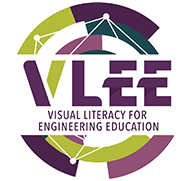Visual Literacy is acknowledged to be of great importance in many professions, commonly in art and design, but also in every domain where visual information plays a significant role. In the case of science and mathematics, Visual Literacy skills are also of most relevance. In engineering it is paramount. Professors Craig L. Miller & and Gary Bertoline stated in 1991 that engineers must be visually literate to be successful engineers.
Visual Literacy in Engineering
Visual Literacy in engineering is reflected in their work development: engineers are problem solvers who handle a lot of visual information. An engineer requires visual means to express completely the results of their work: a mechanical design or an electronic scheme cannot be defined completely by describing it with words, it requires a pictorial description supported by symbols and annotations, which may be concrete (a mechanical object’ drawing) or abstract (an electronic scheme).
Engineers use and produce visuals in all of the technical problem solving tasks, since the identification of the problem to sharing the solution. Engineers need to understand and create messages in visual format as well as to create them to express concepts. These messages are supported in different formats and abstraction degrees. Since schemes, computer graphics, freehand sketches as well as physical models. Engineers use a Visual language which is made up of symbols, standardized pictorial representations and annotations. This is how they understand and produce Visual information of engineering Drawings and sketches reflects Visual Literacy in engineering.
An example of Visual Literacy in engineering is the design intent. How a graphic representation reflects exactly what a design engineers ideated, as well as what an engineer wants to communicate. A set of graphic and text elements are needed to express this idea, so, for achieving that any engineer must be Visual Literate enough to produce this adequate visual message.
One of the most important Visual Literacy skills for engineering is visualization. Being problem solving the main activity of engineering the use of visualization for this purpose is fundamental. To be specific for engineering, visualization means being proficient in handling in mind three-dimensional forms. Spatial abilities are therefore most important.
Other fundamental Visual Literacy skills and abilities are those related to present abstract conceptual ideas graphically, using technical drawing or CAD. These are the skills to draw freehand as well as drafting, and to generate 3D models using computer programs. Visualization is also a required skill in graphic expression as it is necessary to understand projection drawings as well as to generate them.
In that case, engineers apply sketches, engineering drawings, or CADD databases. These are the Visual communication skills specific to engineering. Visual Literacy in engineering involves the use of Visual Thinking, spatial reasoning, the use of 3D modelling, freehand sketching as well as creating physical models.
Visual Literacy in engineering is not only related to the creative side of engineers, but to their analytical tasks. Apart of shapes and functional descriptions of designs, engineers need their visual literacy to express analytical information. They use graphic representation of data in all of the development stages of a product or system, as it is an easy way to explain the results of calculations or empirical data collections. Sharing data by visual means is a key skill for a professional engineer.

